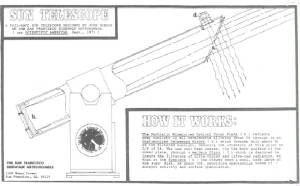A Little Solar Info - by Charles Q. Choi, Space.com Contributor
The atmosphere of the sun is composed of several layers, mainly the photosphere, the chromosphere
and the corona. It's in these outer layers that the sun's energy, which has bubbled up from the sun's interior layers, is
detected as sunlight.
The lowest layer of the sun's atmosphere is the photosphere. It is about 300 miles thick. This
layer is where the sun's energy is released as light. Because of the distance from the Sun to the Earth (about 93 million
miles) light reaches our planet in about eight minutes. The photosphere is marked by bright, bubbling granules of plasma
and darker, cooler sunspots, which emerge when the sun's magnetic field breaks through the surface. Sunspots
appear to move across the sun's disk. Observing this motion led astronomers to realize that the sun rotates on its axis.
The photosphere is also the source of solar flares: a sudden flash of brightness observed over the Sun's
surface which is interpreted as a large energy release. Solar flares produce bursts of X-rays, ultraviolet radiation,
electromagnetic radiation and radio waves. Solar prominences, large, bright, gaseous feature extending
outward from the Sun's surface, often in a loop shape. Prominences are anchored to the Sun's surface in the photosphere,
and extend outwards into the Sun's corona. Temperature of the photosphere is approx. 10,000 degrees F., and sunspots
can get as cool as 7,300 degrees..
The next layer is the chromosphere. The chromosphere emits a reddish glow as super-heated hydrogen
burns off. But the red rim can only be seen during a total solar eclipse. At other times, light from the chromosphere is usually
too weak to be seen against the brighter photosphere. Temperature of the chromospheres is approx 7,800 degrees F.
The
third layer of the sun's atmosphere is the corona. It can only be seen during a total solar eclipse as well. It appears
as white streamers or plumes of ionized gas that flow outward into space. Temperatures
in the sun's corona can get as high as 3.5 million degrees F. As the gases
cool, they become the solar wind.
Observing the
Sun
The electromagnetic spectrum is the range of all possible
wavelengths of electromagnetic radiation, ranging from high energy gamma rays through visible light and down to low energy
radio waves. Various astronomical phenomena can only be observed via specific wavelengths different from visible light. By
scanning the sky in the complete spectrum of electromagnetic radiation via optical telescopes, X-ray telescopes, microwave
telescopes and radio telescopes, astronomers gather information that wouldn't be accessible if they were just observing via
visible light. Visible light is a small fraction of the entire electromagnetic spectrum.
You can view the Sun in white
light or with a Hydrogen Alpha filter. White light is the name given to what the human eye sees when all the colors that make
up the visible light spectrum are combined; the visible light spectrum is made up of red, orange, yellow, green, blue, indigo,
and violet light, and these colors combined make white light. Viewing the Sun in white light requires a filter to block out
almost all of the light. Welder’s glass #14 allows only about 3 millionths of the light hitting it to penetrate.
With this method you will be able to see sunspots and it is a great way to watch eclipses.
A hydrogen alpha (Ha) filter
is used for special kinds of solar observing. The name comes from the alpha emission line of hydrogen, which is in the red
portion of the visible spectrum. Many solar features are most prominent in the red light of this line, and get drowned out
by the intense yellow-white light of the photosphere. With an Ha filter, many solar features, notably prominences, that are
invisible normally become easy to see (without an Ha filter, about the only way to see prominences is to be fortunate enough
to see a total solar eclipse).
